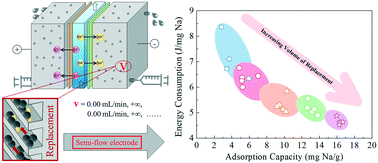Revealing the intrinsic differences between static and flow electrode capacitive deionization by introducing semi-flow electrodes†
Abstract
Flow electrode capacitive deionization (FCDI) is an emerging technology because of its distinctive benefits. However, the understanding of the effects of electrode mobility is limited. In this study, we designed a semi-flow electrode mode as an intermediate state between static and flow electrode modes. The advantages of FCDI were revealed because it could be considered as an extreme condition of the semi-flow mode with infinite time intervals and full volume replacement. It was demonstrated by the semi-flow electrode mode that deionization capacity was directly and proportionally recovered. A higher volume of fresh carbon slurry accounted for higher adsorption capacity as well as lower energy consumption. The timely regeneration of the FCDI electrode slurry enhanced the salt adsorption rate (3-fold) and reduced the specific energy consumption (4.5 ± 0.2 J mg−1 Na in FCDI, 7.0 ± 1.4 J mg−1 Na in the semi-flow electrode and 7.6 ± 0.8 J mg−1 Na in the static mode) for the deionization condition of this study (500 mg Na per L, 1.2 V, 5 wt%). This research provides insights into the fundamental understanding of the FCDI technology, enhancing its performance via the timely regeneration of electrode materials and maintaining the system in a high-efficiency deionization state.

- This article is part of the themed collection: Capacitive deionisation and electrosorption 2020


 Please wait while we load your content...
Please wait while we load your content...